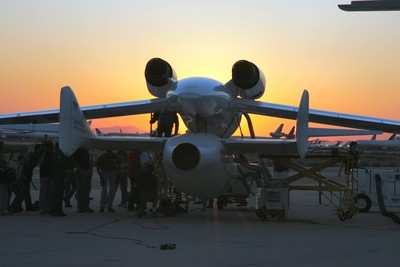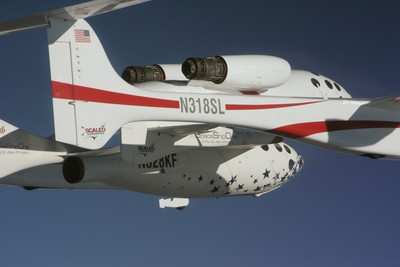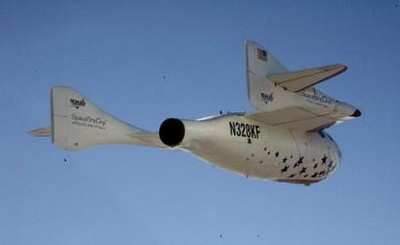Wed, Jun 30, 2004
Scaled Has Released the Mission Summary For Mike Melvill's Trip
Into Space
They thrilled the world... and set a standard for perseverance
and courage that few can ever hope to match -- but the aviation and
aerospace world is still amazed at last week's flight into space...
a flight that cost less than most NASA Paper studies. Here's
Scaled's Mission Summary for Mike's Big Adventure.

Flight 60L / 15P
Date: 21 June 04
Flight Time: 1.6 hour / 24 min 05sec
White Knight Pilot: Binnie White Knight Copilot: Stinemetze
SpaceShipOne Pilot:
Melvill
High Chase Alpha Jet Crew: Van der Schueren/Johnson
High Chase-Starship Crew:
Karkow/Scherer
Low Chase-Extra Crew: Coleman/Bird

Objectives: First commercial astronaut flight
by exceeding 100 kilometers (328,000 ft)
Results: Cheered down the runway by onlookers,
the White Knight turbojet launch aircraft took off at 647 a.m. PST,
carrying SpaceShipOne under its fuselage to an altitude of 47,000
feet. At 750 a.m. PST, flight engineer Matt Stinemetz released the
spaceship and test pilot Mike Melville immediately fired the hybrid
rocket motor. The rocket burn lasted for 76 seconds rocketing the
vehicle to more than 2.9 Mach or 2150 miles an hour. At motor burn
out, SpaceShipOne was at 180,000 feet and from there coasted the
rest of the way into space reaching an apogee of 328,491 feet.
Melvill experienced weightlessness for approximately 3 �
minutes as the vehicle slowly decelerated to apogee and then
yielding to the pull of gravity commenced its historic return to
earth in the craft's unique entry or feathered configuration.
During the descent the pilot experienced forces greater than 5.0
G's as the vehicle accelerated again to 2.9 Mach. Melvill
reconfigured the vehicle back to a glider at 57,000 feet and over
the next 20 minutes enjoyed a leisurely descent to a graceful
landing at Mojave, the Nation's first inland Space Port.

SpaceShipOne Flight 15P Anomaly: As mentioned
in the post-flight press conference, during SpaceShipOne's historic
flight to 100 kilometers on 21 June 2004 there was a flight control
malfunction. Late in the boost phase, the vehicle s primary pitch
trim control was lost. Scaled views any flight control system
anomaly as a serious matter, but to guard against these problems,
the vehicle has redundancy on all flight-critical systems,
including pitch trim. So when the failure occurred, test pilot Mike
Melvill switched to the backup system and continued the planned
mission. However, the resulting trajectory excursion had two
effects. One, the vehicle didn't climb as high as planned and two,
the space ship re-entered south of the intended recovery point.
This latter effect, while undesirable, was well within the
vehicle's glide capability and SpaceShipOne had no difficulty
flying back to Mojave Space Port for a normal landing.

More News
Light Gun A handheld directional light signaling device which emits a brilliant narrow beam of white, green, or red light as selected by the tower controller. The color and type of>[...]
"The journey to this achievement started nearly a decade ago when a freshly commissioned Gentry, driven by a fascination with new technologies and a desire to contribute significan>[...]
Aero Linx: JAARS, Inc. For decades now, we’ve landed planes on narrow rivers and towering mountains. We’ve outfitted boats and vehicles to reach villages that rarely se>[...]
"Our driven and innovative team of military and civilian Airmen delivers combat power daily, ensuring our nation is ready today and tomorrow." Source: General Duke Richardson, AFMC>[...]
Aircraft Conflict Predicted conflict, within EDST of two aircraft, or between aircraft and airspace. A Red alert is used for conflicts when the predicted minimum separation is 5 na>[...]
 ANN's Daily Aero-Term (04.20.24): Light Gun
ANN's Daily Aero-Term (04.20.24): Light Gun Aero-News: Quote of the Day (04.20.24)
Aero-News: Quote of the Day (04.20.24) ANN's Daily Aero-Linx (04.21.24)
ANN's Daily Aero-Linx (04.21.24) Aero-News: Quote of the Day (04.21.24)
Aero-News: Quote of the Day (04.21.24) ANN's Daily Aero-Term (04.21.24): Aircraft Conflict
ANN's Daily Aero-Term (04.21.24): Aircraft Conflict






